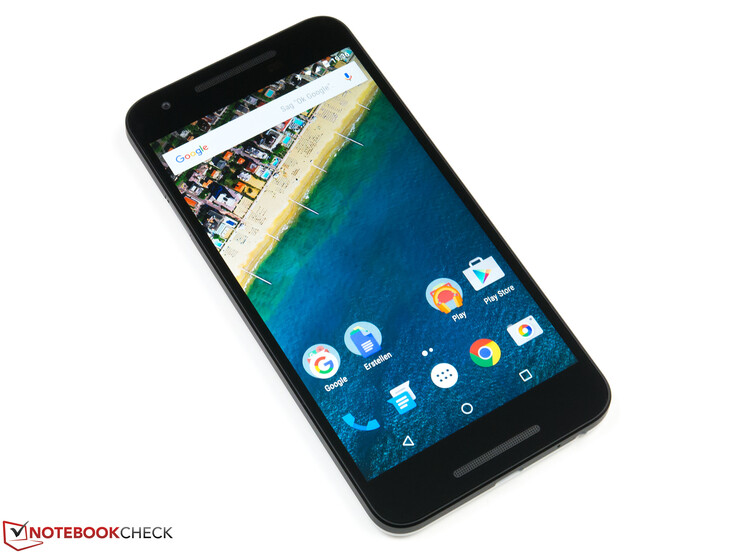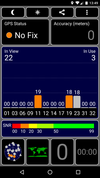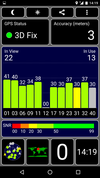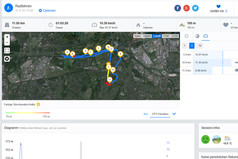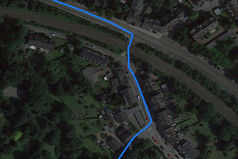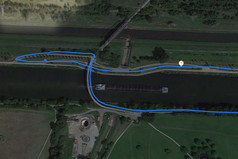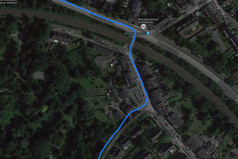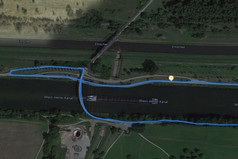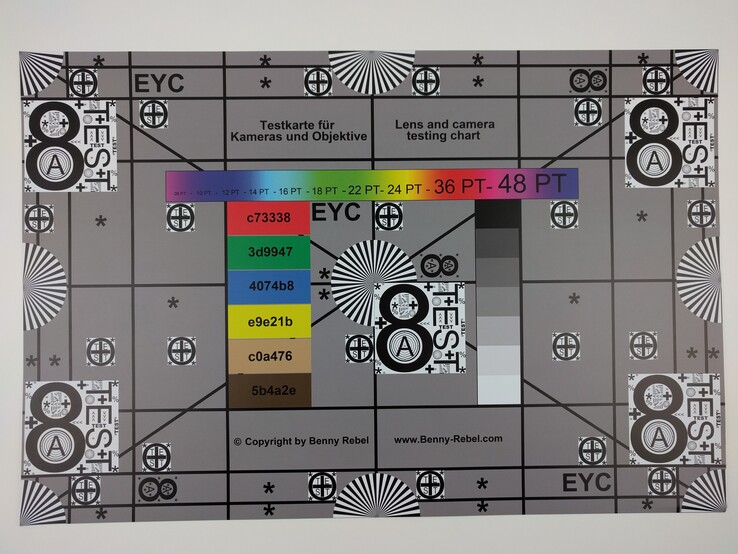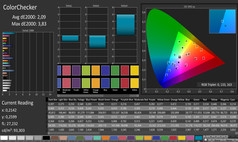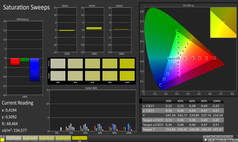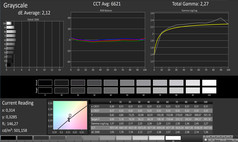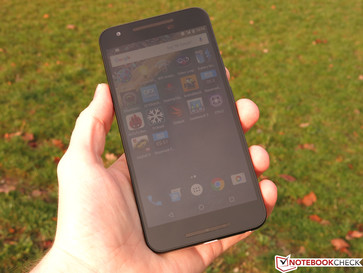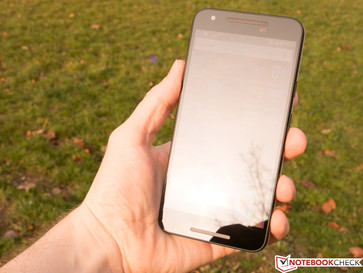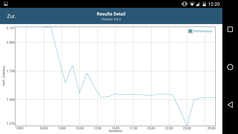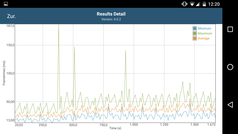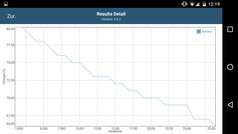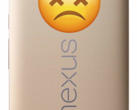Google Nexus 5X Smartphone Review
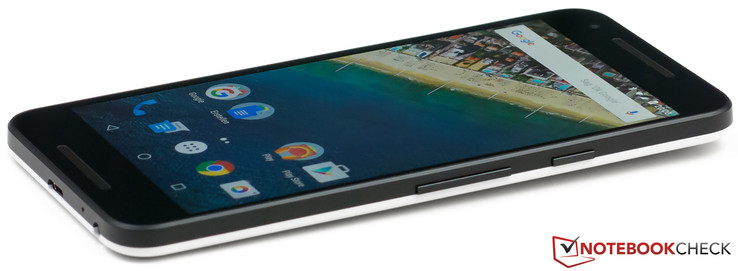
For the original German review, see here.
Google introduces two new smartphones from the Nexus lineup along with its Android 6.0. They are shipped as reference models based on the new operating system: While the Nexus 6P with a 5.7-inch screen follows in the footsteps of the Nexus 6 introduced last year, the Nexus 5X with a 5.2-inch screen can be seen as a delayed successor of the Nexus 5 launched in 2013. Like the latter, the Nexus 5X is built by LG and sold with either 16 GB (479 Euros, ~$526) or 32 GB (529 Euros, ~$581) storage. 2 GB of RAM and Qualcomm's fast Snapdragon 808 hexa-core SoC is always on-board.
Current rivals of the Nexus 5X are, for example, the somewhat less-expensive Android smartphones OnePlus 2 and Honor 7, as well as the Samsung Galaxy S6 Edge and LG G4 that were considerably higher-priced at market launch but whose prices have dropped evidently in the meantime. An alternative based on another operating system would also be Apple's iPhone 6S Plus.
Case
While the Nexus 5X is considerably smaller than last year's Nexus 6, it is still a bit bigger than the indirect predecessor Nexus 5 from 2013. The main reason for this is doubtlessly the slightly bigger screen of now 5.2-inches. The manufacturer also left quite a bit of room for speaker, microphone and sensors above and below the screen. The longest side of LG's G4 with a much bigger 5.5-inch screen is only roughly 2 millimeters longer. The Nexus 5X still makes a handy impression thanks to its moderate weight of 136 grams. Although our measured height of approximately 8 millimeters confirms Google's specified 7.9 millimeter considering measuring tolerances, it does not include the camera module that juts out of the casing by about 2 millimeters. That also prevents the backside of the Nexus 5X from lying absolutely flat on sleek surfaces. However, the tendency for lateral rocking during normal use is not very big.
Parts of the casing of most other premium-range smartphones are made of materials deemed especially high-quality, such as glass or metal. Not so the Nexus 5X that is completely composed of plastic with exception of the display cover. That is not at all a drawback: The handset provides a secure grip thanks to the surface's matte, slip-resistant texture. The build is also impeccable. The smartphone's rigidness does not give any reason for complaint. The Nexus 5X successfully defies twisting attempts. It does not produce disconcerting noises nor does it warp noticeably.
Connectivity
A big point of criticism for many who always want to have their photos, music or video collection at hand will likely be the scanty storage capacity of Google's new smartphone. The user only has almost 25 GB for personal use even in the more expensive model with a 32 GB flash memory. That is a step backward compared with last year's Google Nexus 6 that was also available with up to 64 GB internal storage. Since there is no micro-SD slot - like common for all Nexus devices - data will have to be stored in the cloud or on external storage devices sooner or later. Especially users of the new UHD video feature that guzzles approximately 300 MB per recorded second would definitely have benefited from a somewhat larger storage capacity.
Rather than the conventional micro-USB port that has been installed in smartphones for quite some time now, the Nexus 5X sports a cutting edge USB Type C port. Thus, the data cable can be inserted "upside down" turned 180 degrees, and the user no longer has to think about what side is right way up. However, it is a bit too bad that data can only be transmitted in the old USB 2.0 standard (approx. 40 MB/s) and an adapter for connecting common USB Type A ports is not included. Furthermore, the port supports USB OTG for connecting external storage devices or peripherals.
Video output via MHL or Slimport is not intended. Instead, streaming in the local network via Miracast and DLNA is supported. The latest Bluetooth version 4.2 and NFC is also integrated. Beyond that, the reliable fingerprint reader on the smartphone's rear and the multi-color notification LED behind the lower speaker grille are useful.
Software
A highlight of the 5X is the standard downloading of the newest Android version as common for Nexus smartphones. The device is shipped with the latest Android 6.0 Marshmallow and obtains regular OTA updates directly from Google.
The new operating system does not look much different than its predecessor Android 5.1.1. The most striking difference is the now vertical rather than horizontal scroll bar of installed apps. The Ambient Display feature known from the former Nexus 6 is also on-board. It displays the current time and existing notifications via the movement sensor, e.g. when picking up the smartphone.
A feature found in some Android smartphones modified by manufacturers has now also officially moved into Google's Android version: A rights manager for installed apps. The user can now cancel single rights for specified apps, such as location or camera access. More information concerning Android Marshmallow can be found in our news report.
Communication & GPS
The Nexus 5X is throughout convincing in terms of wireless communication. For example, it features a fast dual-band AC Wi-Fi module that enables gross data rates of up to 866 Mbit/s (2x 2 MIMO), and which presented above average reception qualities in both the 2.4 GHz and 5 GHz frequencies in the test using an Asus RT-AC56U router. The integrated radio modem is also very satisfactory: It supports a multitude of frequency bands. A maximum browsing speed of 300 Mbit/s in downstream and 50 Mbit/s in upstream is possible via LTE. The latest Bluetooth version 4.2 and NFC is also integrated for wireless near field communication.
The GPS module in the Nexus 5X very reliably and quickly located our position. However, tracking was not possible in a four-story apartment building. To find out how well the handset functions in real-world use, we recorded a route for comparison using the Garmin Edge 500 GPS bike computer alongside the Nexus 5X. The smartphone is compelling here: Both the low deviation of only 1% between the devices and the accurate tracing of the driven route speak for the very good performance of Google's reference model. Although it did not record our short loop in the turning point area, the route is a bit more accurate than that of the bike computer with digital maps here. Therefore, the Nexus 5X is perfectly suitable for navigation purposes.
Telephone & Call Quality
The phone app includes features known from Android Lollipop, such as favorites, call lists, contacts and search. A keypad can also be faded in when required. The app is overall quite basic, which results in a very clear arrangement.
The intelligibility was very good during normal calls at both ends in test calls in the German Telecom 3G network. The earpiece's high maximum volume has to be highlighted here. Its sound is already decent, but the natural-sounding voice at the other end has to be lauded and speaks for an especially good quality of the microphone installed in the Nexus 5X. Even hands-free mode does not change much about the good intelligibility at both ends although slight distortions in higher volumes let it sound a bit more unnatural. A headset is not included.
Cameras & Multimedia
The cameras used in Nexus devices in the past were not their strength. However, the Nexus 5X does a good job here. The rear-facing model shoots photos with up to 12.3 megapixels (4032x3024 pixels) and has a relatively wide aperture of f/2.0. The lens additionally finds support in an IR laser auto-focus. Very sharp pictures that still display many details when zoomed are created in daylight. The illumination, color impression and responsiveness do not give much reason for complaint subjectively. However, the camera does not do quite as good job in low-light. A fairly heavy image noise becomes evident, which can be lessened by using the bright, warm-white dual-LED flash.
The front camera has a resolution of 5 megapixels as well as an aperture of f/2.0. The photos look quite blurred in default camera mode - not much of the 5 megapixels is seen here. That might just be intentional since that, for example, leads to a smoother-looking complexion in selfies. The photo looks considerably more high-detail when enabling the optional HDR, but the image noise increases visibly at the same time.
The modes "Photo Sphere", "Panorama" and "Focus Effect" are installed in addition to the normal camera mode. Live filters or manually setting ISO rates, shutter speed, etc. are generally not intended.
The primary camera in the Nexus 5X records videos in the UHD resolution (2840x2160 pixels) at up to 30 frames per second. The data rate of approximately 42 Mbit/s is relatively high here so that freeze-images display good quality (see sample screenshot). Unfortunately, we discovered some minor incompatibilities with popular video players in the test. For example, it was not possible to render UHD videos recorded with the Nexus 5x smoothly on a Window 8.1 test system with an Intel Core i7 processor via "VLC Player", although they were compressed via the common H.264 codec. "Media Player Classic Home Cinema" displayed the video stutter-free, but upside down. The playback essentially ran properly in "Windows Media Player", but with visible pixel flickering. Solely "PotPlayer" delivered a perfect picture. The Full HD videos recorded with the front camera look smooth and have a decent quality in good light; the details blur in darker environments.
Color Accuracy & Sharpness

We compare the photo of XRite ColorChecker Passport taken under controlled light conditions with the factual reference colors for testing the color accuracy of the Nexus 5X's primary camera. No image editing, e.g. manual white balance, was performed.
It becomes obvious that particularly blue and orange tones in the right half of the image are quite accurate. The Nexus 5X's reproduction of the color fields on the left is too dark, which leads to an increased image contrast.
We take an edge-to-edge picture of our test chart under defined artificial light to judge the image sharpness. Here, in line with the real-world pictures, a very good sharpness that does not decrease excessively towards the edges is evident.
Accessories
The accessories included are very limited. Only a small tool for opening the SIM-card slot and various leaflets (quick-start guide, warranty conditions, Google Play Music 90-day trial) are found in the box besides the potent power supply with USB Type C cable (15W, 5V, 3A). Google offers an adapter for common USB Type A cables and various cases in its Play Store for a surcharge.
Warranty
Being the smartphone manufacturer, LG includes a two-year warranty on the handset. That, however, excludes the included power supply and its cable and the non-removable battery (6-month warranty).
Input Devices & Handling
Gorilla Glass 3 protects the touchscreen in the Nexus 5X. It responds very accurately to inputs. The fingers also glide easily over the surface. That especially facilitates inputting on the virtual keyboard and typos are less frequent. The palpable vibration feedback is also helpful in this context. Since a Nexus smartphone is naturally furnished with Google's stock keyboard, no special features like extended gesture control or additional keys are installed. All really important features can be accessed with only a few clicks.
The physical keys situated on the casing's right have an agreeable pressure point and also make a very rigid impression despite a bit too much play towards the sides. The angular shape makes them quite easy to find, but they also feel slightly sharp due to that.
The fingerprint reader is on the smartphone's rear and responds very quickly and reliably. Unlocking the handset is noticeably easier this way - compared with inputting a PIN or an unlock pattern.
The Nexus 5X does not know the meaning of lags or stutters. The operating system always responded smoothly to user inputs. The image is realigned quickly when the handset is rotated.
Display
The Nexus 5X is furnished with a 5.2-inch IPS panel in Full HD resolution, which equals a pixel density of 424 PPI. Some premium-range rivals can boast with even higher rates, but the review sample is in no way inferior to them. Content looks very sharp; pixel arrangements are not at all visible at a normal viewing distance.
The brightness achieves a decent rate of 503 cd/m² in the center of a completely white screen. The illumination of 97% is unusually homogeneous. The Nexus 5X positions itself in the upper midfield in the comparison group with these rates. Solely LG's G4 and Apple's iPhone 6S Plus are even brighter. However, the measurements made with equally distributed bright and dark areas on the display are more significant (average picture level/APL 50). No differences to the maximum brightness compared with a completely white image are ascertained here. Enabling the brightness sensor does not change the rates, either.
The good black level of 0.38 cd/m² results in an above average contrast ratio of 1324:1 for an IPS panel. The image also looks very vivid subjectively; no visible grayish tint covers black surfaces.
| |||||||||||||||||||||||||
Brightness Distribution: 97 %
Center on Battery: 503 cd/m²
Contrast: 1324:1 (Black: 0.38 cd/m²)
ΔE ColorChecker Calman: 2.09 | ∀{0.5-29.43 Ø4.77}
ΔE Greyscale Calman: 2.12 | ∀{0.09-98 Ø5}
Gamma: 2.27
CCT: 6621 K
| Google Nexus 5X 1920x1080 px 5.2'' (IPS) | Google Nexus 5 1920x1080 px 5.0'' (IPS) | Google Nexus 6 2560x1440 px 6.0'' (AMOLED) | LG G4 2560x1440 px 5.5'' (IPS) | OnePlus 2 1920x1080 px 5.5'' (IPS) | Honor 7 1920x1080 px 5.2'' (IPS) | Apple iPhone 6S Plus 1920x1080 px 5.5'' (IPS) | Samsung Galaxy S6 Edge 2560x1440 px 5.1'' (AMOLED) | |
|---|---|---|---|---|---|---|---|---|
| Screen | ||||||||
| Brightness middle (cd/m²) | 503 | 469 -7% | 274 -46% | 566 13% | 451 -10% | 442 -12% | 583 16% | 343 -32% |
| Brightness (cd/m²) | 498 | 452 -9% | 264 -47% | 536 8% | 446 -10% | 440 -12% | 560 12% | 338 -32% |
| Brightness Distribution (%) | 97 | 94 -3% | 89 -8% | 90 -7% | 90 -7% | 92 -5% | 91 -6% | 94 -3% |
| Black Level * (cd/m²) | 0.38 | 0.49 -29% | 0.47 -24% | 0.3 21% | 0.23 39% | 0.46 -21% | ||
| Contrast (:1) | 1324 | 957 -28% | 1204 -9% | 1503 14% | 1922 45% | 1267 -4% | ||
| Colorchecker dE 2000 * | 2.09 | 2.05 2% | 6.99 -234% | 6.17 -195% | 3.84 -84% | 4.52 -116% | 3.55 -70% | 2.2 -5% |
| Greyscale dE 2000 * | 2.12 | 1.45 32% | 4.01 -89% | 6.26 -195% | 3.97 -87% | 5.47 -158% | 3.88 -83% | 2.37 -12% |
| Gamma | 2.27 97% | 2 110% | 2.03 108% | 2.48 89% | 2.46 89% | 2.27 97% | 2.2 100% | 2.41 91% |
| CCT | 6621 98% | 6441 101% | 6329 103% | 8171 80% | 7283 89% | 7874 83% | 7280 89% | 6425 101% |
| Color Space (Percent of AdobeRGB 1998) (%) | 65.48 | 58.07 | 59.05 | 87.77 | ||||
| Color Space (Percent of sRGB) (%) | 98.63 | 90.14 | 99.7 | 92.8 |
* ... smaller is better
The Nexus 5X also shows its good side in terms of color reproduction. No current smartphone in the comparison field outperforms it thanks to an average DeltaE shift of 2.09 (colors) and 2.12 (grayscale) from the ideal range of <3. Only the now two-year old Nexus 5 can pit itself against the new model. The Nexus 5X's gamma rate of 2.27 and the temperature of 6621 K is close to the ideal of 2.2 and 6500 K.
The high image contrast is a plus for using the Nexus 5X outdoors. Its brightness is usually high enough to recognize displayed content fairly well when direct sunlight is avoided. The user would, however, benefit from a slightly higher maximum brightness and/or a better AR coating on the glass surface on clear days.
The Nexus 5X's viewing-angle stability is also good. Inverting is not an issue thanks to the IPS panel, and the color reproduction barely changed in flat angles. However, brightness decrease is visible. Although the typical IPS glow effect, i.e. dark areas brighten up in very acute viewing angles, is present, it is not particularly prominent.
Performance
The Nexus 5X is furnished with a Qualcomm Snapdragon 808 SoC that is also found in, for example, LG's G4 flagship. Its four frugal Cortex A53 cores (max. 1.5 GHz) are supported by two Cortex A57 cores (max. 1.8 GHz), making it one of the fastest processors on the market. An Adreno 418 GPU is integrated for video output.
The Nexus 5X only finds a place in the midfield in most benchmarks due to the rivals' high performance levels. It usually only outperforms Honor's 7 and the two-year old Nexus 5. LG's G4 is also outrun in graphic tests, such as the T-Rex onscreen benchmark since its Adreno 418 GPU has to power a considerably higher resolution screen. We only observe a low point in the Linpack benchmark where the Nexus 5X is the taillight. We assume that only the SoC's relatively slow Cortex A53 core was utilized in the test. Therefore, conclusions regarding the smartphone's actual performance cannot really be made here.
| AnTuTu v5 - Total Score (sort by value) | |
| Google Nexus 5X | |
| Google Nexus 5 | |
| Google Nexus 6 | |
| LG G4 | |
| OnePlus 2 | |
| Honor 7 | |
| Apple iPhone 6S Plus | |
| Samsung Galaxy S6 Edge | |
| Geekbench 3 | |
| 64 Bit Multi-Core Score (sort by value) | |
| Google Nexus 5X | |
| LG G4 | |
| OnePlus 2 | |
| Honor 7 | |
| Apple iPhone 6S Plus | |
| Samsung Galaxy S6 Edge | |
| 64 Bit Single-Core Score (sort by value) | |
| Google Nexus 5X | |
| LG G4 | |
| OnePlus 2 | |
| Honor 7 | |
| Apple iPhone 6S Plus | |
| Samsung Galaxy S6 Edge | |
| PCMark for Android - Work performance score (sort by value) | |
| Google Nexus 5X | |
| Google Nexus 5 | |
| LG G4 | |
| OnePlus 2 | |
| Honor 7 | |
| Samsung Galaxy S6 Edge | |
| GFXBench (DX / GLBenchmark) 2.7 | |
| T-Rex Onscreen (sort by value) | |
| Google Nexus 5X | |
| Google Nexus 5 | |
| Google Nexus 6 | |
| LG G4 | |
| OnePlus 2 | |
| Honor 7 | |
| Apple iPhone 6S Plus | |
| Samsung Galaxy S6 Edge | |
| 1920x1080 T-Rex Offscreen (sort by value) | |
| Google Nexus 5X | |
| Google Nexus 5 | |
| Google Nexus 6 | |
| LG G4 | |
| OnePlus 2 | |
| Honor 7 | |
| Apple iPhone 6S Plus | |
| Samsung Galaxy S6 Edge | |
| 3DMark | |
| 1280x720 offscreen Ice Storm Unlimited Score (sort by value) | |
| Google Nexus 5X | |
| Google Nexus 5 | |
| Google Nexus 6 | |
| LG G4 | |
| OnePlus 2 | |
| Honor 7 | |
| Apple iPhone 6S Plus | |
| Samsung Galaxy S6 Edge | |
| 1280x720 offscreen Ice Storm Unlimited Graphics Score (sort by value) | |
| Google Nexus 5X | |
| Google Nexus 5 | |
| Google Nexus 6 | |
| LG G4 | |
| OnePlus 2 | |
| Honor 7 | |
| Apple iPhone 6S Plus | |
| Samsung Galaxy S6 Edge | |
| 1280x720 offscreen Ice Storm Unlimited Physics (sort by value) | |
| Google Nexus 5X | |
| Google Nexus 5 | |
| Google Nexus 6 | |
| LG G4 | |
| OnePlus 2 | |
| Honor 7 | |
| Apple iPhone 6S Plus | |
| Samsung Galaxy S6 Edge | |
| 2560x1440 Sling Shot Extreme (ES 3.1) (sort by value) | |
| Google Nexus 5X | |
| LG G4 | |
| OnePlus 2 | |
| Honor 7 | |
| Apple iPhone 6S Plus | |
| Samsung Galaxy S6 Edge | |
| 2560x1440 Sling Shot Extreme (ES 3.1) Graphics (sort by value) | |
| Google Nexus 5X | |
| LG G4 | |
| OnePlus 2 | |
| Honor 7 | |
| Apple iPhone 6S Plus | |
| Samsung Galaxy S6 Edge | |
| 2560x1440 Sling Shot Extreme (ES 3.1) Physics (sort by value) | |
| Google Nexus 5X | |
| LG G4 | |
| OnePlus 2 | |
| Honor 7 | |
| Apple iPhone 6S Plus | |
| Samsung Galaxy S6 Edge | |
| GFXBench 3.1 | |
| 1920x1080 Manhattan ES 3.1 Offscreen (sort by value) | |
| LG G4 | |
| OnePlus 2 | |
| Apple iPhone 6S Plus | |
| Samsung Galaxy S6 Edge | |
| on screen Manhattan ES 3.1 Onscreen (sort by value) | |
| LG G4 | |
| OnePlus 2 | |
| Apple iPhone 6S Plus | |
| Samsung Galaxy S6 Edge | |
The Nexus 5X is better in the browser tests than in the benchmark programs. Solely Samsung's premium-range Galaxy S6 Edge and Apple's iPhone 6S Plus achieve better scores. A reason is likely the optimized Android 6.0.
| Octane V2 - Total Score (sort by value) | |
| Google Nexus 5X | |
| Google Nexus 5 | |
| Google Nexus 5 | |
| Google Nexus 6 | |
| LG G4 | |
| OnePlus 2 | |
| Honor 7 | |
| Apple iPhone 6S Plus | |
| Samsung Galaxy S6 Edge | |
| Sunspider - 1.0 Total Score (sort by value) | |
| Google Nexus 5X | |
| Google Nexus 5 | |
| Google Nexus 5 | |
| Google Nexus 6 | |
| LG G4 | |
| OnePlus 2 | |
| Honor 7 | |
| Apple iPhone 6S Plus | |
| Samsung Galaxy S6 Edge | |
| Mozilla Kraken 1.1 - Total (sort by value) | |
| Google Nexus 5X | |
| Google Nexus 5 | |
| Google Nexus 6 | |
| LG G4 | |
| OnePlus 2 | |
| Honor 7 | |
| Apple iPhone 6S Plus | |
| Samsung Galaxy S6 Edge | |
| WebXPRT 2015 - Overall (sort by value) | |
| Google Nexus 5X | |
| Google Nexus 5 | |
| LG G4 | |
| OnePlus 2 | |
| Honor 7 | |
| Apple iPhone 6S Plus | |
| Google V8 Ver. 7 - Google V8 Ver. 7 Score (sort by value) | |
| Google Nexus 5X | |
| Google Nexus 5 | |
| Google Nexus 6 | |
| LG G4 | |
| OnePlus 2 | |
| Honor 7 | |
| Apple iPhone 6S Plus | |
| Samsung Galaxy S6 Edge | |
| JetStream 1.1 - Total Score (sort by value) | |
| Google Nexus 5X | |
| Google Nexus 5 | |
| LG G4 | |
| OnePlus 2 | |
| Honor 7 | |
| Apple iPhone 6S Plus | |
| Samsung Galaxy S6 Edge | |
* ... smaller is better
LG installs a - compared with both former models - much faster 32 GB flash memory. In total, the Nexus 5X delivers write and read rates that can definitely compete with the upper-range comparison devices without achieving any new top rates.
| BaseMark OS II - Memory (sort by value) | |
| Google Nexus 5X | |
| Google Nexus 5 | |
| Google Nexus 6 | |
| LG G4 | |
| OnePlus 2 | |
| Honor 7 | |
| Apple iPhone 6S Plus | |
| Samsung Galaxy S6 Edge | |
Games
Although the Adreno 418 GPU in the Nexus 5X is approximately 20% weaker than the Adreno 420 GPU in Google's Nexus 6 reference phone from last year, even demanding games like Asphalt 8 can be rendered smoothly on the Full HD screen using maximum settings. Consequently, less demanding games like Angry Birds 2 also run without problems.
The integrated position sensor and the sensitive touchscreen also function very well, making precise control in games possible. The Nexus 5X also collects plus points for the front-sided speaker that is not covered when holding the smartphone in landscape mode.
Emissions
Temperature
With idle temperatures of just over 25 °C, the Nexus 5X hardly heats up noticeably in idle mode. The handset is also unexpectedly cool under load despite the relatively strong SoC. The hottest spot measured reaches just 37.4 °C here - other premium smartphones often surpass 40 °C. The review sample can even shine with the lowest rates compared with its rivals.
But how does LG manage this balancing act between high performance and only moderate temperatures? The battery test of GFXBench unravels this mystery. It runs the T-Rex test thirty times in succession and records the achievable performance, temperature increase and battery consumption. A performance drop of approximately 20% is seen after the benchmark's sixth run, which increases up to 40% in the further course. That is particularly disappointing since LG managed a much more stable performance in the G4 with the same SoC.
(+) The maximum temperature on the upper side is 34.4 °C / 94 F, compared to the average of 35.2 °C / 95 F, ranging from 21.9 to 247 °C for the class Smartphone.
(+) The bottom heats up to a maximum of 37.4 °C / 99 F, compared to the average of 34 °C / 93 F
(+) In idle usage, the average temperature for the upper side is 26.5 °C / 80 F, compared to the device average of 32.9 °C / 91 F.
Speaker
According to the manufacturer's spec sheet, the Nexus 5X is furnished with stereo speaker/s for maximum music enjoyment. This allegation can confidently be seen as a pure catchphrase. While the maximum volume can still be called middling, that is only conditionally true for music playback. Music always sounds somewhat tinny and distorts increasingly in higher volumes. A stereo effect is also not audible since the sound only reaches the user's ear from the lower of the two perforated grilles.
However, the speaker is well-suitable for hands-free utilization; speech remains well-intelligible even in higher volumes. The positioning on the handset's front is also advantageous since the sound is not muffled when placed on a table or in the user's hand.
Connecting standard headphones or headsets is possible via the 3.5 mm jack; the sound was impeccable here.
Energy Management
Power Consumption
No surprises are discovered in power consumption. Solely the weaker Nexus 5 from 2013 and Samsung's Galaxy S6 Edge with an AMOLED panel are considerably more frugal. The Nexus 5X is found in the midfield of the comparison devices in most tests. Only the maximum power consumption seems relatively high in view of the sooner compact screen size of 5.2-inches in the comparison field. Although no new records are set, this outcome can be called throughout solid.
The included power supply has a maximum output of 15 watts (5V, 3A) and can recharge the 2700 mAh battery completely within approximately 100 minutes. Half the capacity is reached in roughly 30 minutes. When connected to a conventional USB 3.0 port (Type A), the entire procedure needs about two-and-a-half times longer using a corresponding, not included cable. Wireless charging is not possible.
| Off / Standby | |
| Idle | |
| Load |
|
Key:
min: | |
| Google Nexus 5X Adreno 418, 808 MSM8992, 32 GB eMMC Flash | Google Nexus 5 Adreno 330, 800 MSM8974, 16 GB iNAND Flash | Google Nexus 6 Adreno 420, 805 APQ8084, 32 GB eMMC Flash | LG G4 Adreno 418, 808 MSM8992, 32 GB eMMC Flash | OnePlus 2 Adreno 430, 810 MSM8994, 64 GB eMMC Flash | Honor 7 Mali-T628 MP4, Kirin 935, 64 GB eMMC Flash | Apple iPhone 6S Plus A9 / PowerVR GT7600, A9, Apple AP0064K (iPhone NVMe) | Samsung Galaxy S6 Edge Mali-T760 MP8, Exynos 7420, 32 GB UFS 2.0 Flash | |
|---|---|---|---|---|---|---|---|---|
| Power Consumption | ||||||||
| Idle Minimum * (Watt) | 0.55 | 0.3 45% | 1.2 -118% | 1.1 -100% | 0.6 -9% | 1.7 -209% | 0.5 9% | 0.5 9% |
| Idle Average * (Watt) | 1.44 | 0.8 44% | 1.5 -4% | 1.5 -4% | 1.7 -18% | 2.9 -101% | 1.9 -32% | 0.9 37% |
| Idle Maximum * (Watt) | 1.9 | 1 47% | 1.7 11% | 1.9 -0% | 1.8 5% | 3.3 -74% | 2.2 -16% | 1.3 32% |
| Load Average * (Watt) | 3.36 | 4.3 -28% | 4.8 -43% | 6.6 -96% | 5.7 -70% | 4.9 -46% | 3.2 5% | 3.8 -13% |
| Load Maximum * (Watt) | 9.76 | 8.4 14% | 10.9 -12% | 8.8 10% | 6 39% | 8.2 16% | 6.4 34% | 6.8 30% |
* ... smaller is better
Battery Runtime
Some new energy-saving features such as "Doze" and "App Standby" have now been implemented in Android 6.0, and they should lead to better battery runtimes. The test outcomes indicate that they might in fact have a positive effect. The Nexus 5X places itself at the top of the comparison field in both maximum load and idle mode and even outperforms devices with a nominally stronger battery. However, it only achieves midfield in both Wi-Fi browsing and video rendering. The Wi-Fi test rates of the Nexus 5 and Nexus 6 can no longer be directly compared with those of more recent smartphones due to a modified, more demanding test procedure.
An energy-saving mode takes effect on the smartphone's power consumption either automatically or manually at a specified rest battery capacity depending on the settings. It reduces the handset's performance and potential background activities. The user also has to waive the vibration feature.
| Google Nexus 5X Adreno 418, 808 MSM8992, 32 GB eMMC Flash | Google Nexus 5 Adreno 330, 800 MSM8974, 16 GB iNAND Flash | Google Nexus 6 Adreno 420, 805 APQ8084, 32 GB eMMC Flash | LG G4 Adreno 418, 808 MSM8992, 32 GB eMMC Flash | OnePlus 2 Adreno 430, 810 MSM8994, 64 GB eMMC Flash | Honor 7 Mali-T628 MP4, Kirin 935, 64 GB eMMC Flash | Apple iPhone 6S Plus A9 / PowerVR GT7600, A9, Apple AP0064K (iPhone NVMe) | Samsung Galaxy S6 Edge Mali-T760 MP8, Exynos 7420, 32 GB UFS 2.0 Flash | |
|---|---|---|---|---|---|---|---|---|
| Battery runtime | ||||||||
| Reader / Idle (h) | 29.6 | 18.5 -37% | 19.2 -35% | 27.6 -7% | 23.2 -22% | 14.8 -50% | 27.6 -7% | 22.5 -24% |
| H.264 (h) | 9.3 | 10.9 17% | 8.4 -10% | 9.7 4% | 9.2 -1% | 11.9 28% | 7 -25% | |
| WiFi v1.3 (h) | 6.9 | 5.4 -22% | 5.9 -14% | 8.1 17% | 8.6 25% | 8.9 29% | ||
| Load (h) | 4.1 | 3.1 -24% | 2.3 -44% | 1.9 -54% | 3.8 -7% | 4 -2% | 3.3 -20% | 3.7 -10% |
| WiFi (h) | 12.2 | 10 |
Pros
Cons
Verdict
The at first glance relatively restrained-looking Nexus 5X conceals cutting-edge technology under its hood. Besides a modern Snapdragon SoC, all state-of-the-art wireless standards such as AC Wi-Fi at up to 866 Mbit/s, Bluetooth 4.2 and NFC are on-board. A variety of mobile network standards is also supported. The integrated fingerprint reader that functions reliably and almost without delays and the very accurate GPS module are other technical treats. The screen also reaps in many plus points with its decent brightness, very good contrast rates, and accurate color reproduction.
The smartphone's primary camera shoots razor-sharp photos in bright surroundings and quickly finds the right focal point thanks to laser support. The bright dual-LED often cannot prevent the image quality from decreasing in dim light. However, image noise increases strongly without it or when the object is further away. Details are then also lost. The option of recording UHD videos is also great, but the tight storage capacity might quickly become a problem. Nexus 5X users will not have more than 32 GB; the base configuration even only offers a 16 GB flash memory.
The Nexus 5X scores in many aspects in routine use. It worthily treads in the footsteps of its indirect predecessor Nexus 5 with a decent battery life, always smoothly responding operating system, and a casing that shines with stability and high-quality build.
Nexus buyers do not have to worry too much about Android updates since they will receive them before many others directly from Google. In addition to the non-expandable storage, the price of 529 Euros (~$581) will likely be the biggest obstacle for the smartphone's success. Many competing products are presently sold at a considerably lower price or offer more for the money. For example, LG's G4 is now available for a price starting at around 450 Euros (~$494) and also lures with an expandable storage and larger 5.5-inch screen.
Google Nexus 5X
- 12/23/2015 v4 (old)
Andreas Kilian


